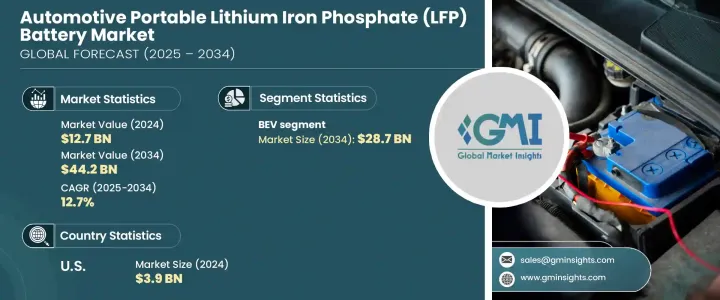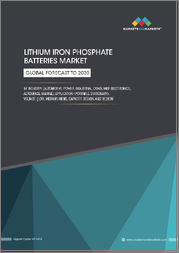
|
시장보고서
상품코드
1750548
세계의 자동차 휴대용 리튬 인산철 배터리 시장 : 기회, 성장 촉진요인, 산업 동향 분석 및 예측(2025-2034년)Automotive Portable Lithium Iron Phosphate (LFP) Battery Market Opportunity, Growth Drivers, Industry Trend Analysis, and Forecast 2025 - 2034 |
||||||
세계의 자동차 휴대용 리튬 인산철(LFP) 배터리 시장은 2024년 127억 달러로 평가되었고 2034년까지 442억 달러에 이를 것으로 추정되며, CAGR 12.7%로 성장할 전망입니다.
LFP 배터리는 안전성, 우수한 열 안정성, 과열 방지 특성으로 인해 널리 주목을 받고 있으며, 이러한 특성으로 인해 전기자동차에 이상적인 선택으로 자리매김하고 있습니다. 특히 보급형 및 중형 EV 부문에서 비용 효율적이고 신뢰할 수 있는 배터리 기술에 대한 수요가 증가함에 따라 LFP 배터리는 필수적인 솔루션이 되고 있습니다. 다른 화학 물질에 비해 열 폭주 위험이 낮기 때문에 승객의 안전이 크게 향상되며, 이는 소비자의 구매 결정과 OEM 전략에 영향을 미치는 주요 요인이 되고 있습니다.

자동차 산업은 기존 배터리 유형에 비해 여러 가지 장점을 제공하는 리튬 인산철 기술로 눈에 띄게 전환되고 있습니다. 긴 수명, 경쟁력 있는 가격, 향상된 안전성으로 LFP 배터리는 전기자동차 사용자에게 특히 매력적입니다. 그 결과, 더 많은 자동차 제조업체들이 자사 제품 라인, 특히 접근성과 경제성을 중시한 모델에 이러한 배터리를 채택하고 있습니다. LFP 기술에 대한 의존도가 높아짐에 따라 생산 비용을 늘리지 않고도 지속 가능성과 성능이라는 업계 목표를 달성할 수 있게 되었습니다. 또한, 탄소 배출을 최소화해야 하는 규제 압력으로 인해 자동차 제조업체들은 안전 기준을 충족할 뿐 아니라 친환경 에너지 이니셔티브에도 부합하는 배터리 화학 물질에 집중하고 있습니다. LFP 배터리의 인기가 높아짐에 따라 제조업체들은 전체적인 차량 성능과 사용자 만족도를 높이기 위해 에너지 밀도 및 고속 충전 기술의 발전을 모색하고 있습니다.
| 시장 범위 | |
|---|---|
| 시작 연도 | 2024년 |
| 예측 연도 | 2025년-2034년 |
| 시작금액 | 127억 달러 |
| 예측 금액 | 442억 달러 |
| CAGR | 12.7% |
용도별로 자동차 휴대용 LFP 배터리 시장은 자동차 휴대용 LFP 배터리 시장은 하이브리드 전기자동차(HEV)와 배터리 전기자동차(BEV)로 구분됩니다. 2024년에는 HEV 부문이 시장 점유율의 58.9%를 차지할 것으로 예상됩니다. HEVs는 전통적인 내연 기관과 완전 전기 시스템 사이의 균형을 제공하며, 전 세계 전기화 이동 수단 전환에서 중요한 역할을 하고 있습니다. 그들의 확산은 광범위한 충전 인프라 없이 연료 효율성을 향상시키고 배출량을 줄일 수 있는 능력에서 비롯됩니다. 안정적인 성능과 긴 수명으로 알려진 LFP 배터리는 빈번한 충전과 내구성이 필수적인 하이브리드 시스템에 적합합니다.
현재 HEV가 시장을 지배하고 있지만, BEV 부문은 상당한 성장을 앞두고 있으며 2034년에는 매출이 287억 달러를 넘어설 것으로 예상됩니다. 충전 인프라의 확대와 배터리 비용의 하락으로 BEV는 더 많은 고객에게 접근하기 쉬워지고 있습니다. 주행 거리 불안감이 감소하고 완전 전기화 촉진 정책이 강화되면서 BEV는 자동차 시장 점유율을 확대할 것으로 예상되며, LFP 배터리는 비용 효율성과 신뢰성 있는 성능으로 인해 선호되는 전원 공급원으로 자리매김할 것입니다. 시장 성장 동력은 소비자의 저유지보수 솔루션 선호와 LFP 기술의 안전성에 대한 신뢰도 강화에서 비롯되고 있습니다.
미국에서는 자동차 휴대용 LFP 배터리 시장이 꾸준한 성장을 보이고 있습니다. 이 산업은 2022년에 28억 달러로 평가되었지만, 2023년에는 33억 달러로 증가했으며, 2024년에는 39억 달러에 도달할 것으로 예상됩니다. 여러 정부 주도의 이니셔티브가 국내 배터리 생산을 촉진하기 위한 인센티브를 제공함으로써 이러한 상승 추세를 가속화하고 있습니다. 현지 전기차 공급망 개발을 촉진하고 국제 의존도를 줄이는 정책은 미국산 차량에 LFP 배터리의 사용을 장려하고 있습니다. 이러한 재정적 지원은 전기차를 더 저렴하고 접근하기 쉽게 만들어, 간접적으로 해당 지역에서 리튬 인산철 배터리 기술의 광범위한 채택을 촉진합니다.
전 세계적으로 자동차 휴대용 LFP 배터리 시장에서는 5개 주요 기업이 시장을 주도하며, 이들이 전체 시장 점유율의 55% 이상을 차지하고 있습니다. 이 기업들은 강력한 공급망 통합과 규모를 바탕으로 규제 환경의 변화에 신속히 대응하고 정부 지원을 받는 계약을 확보할 수 있습니다. 그들의 리더십은 연구 개발에 대한 투자 확대를 가능하게 하며, 특히 에너지 밀도 최적화, 충전 속도 개선, 사용 후 배터리 재활용 등 분야에 집중되고 있습니다. 이 주요 기업들이 도입하는 혁신은 라이선스 계약이나 경쟁 우위 확보를 통해 시장 전반에 영향을 미치며, 산업 표준을 높이고 제품 수명 주기 전반에 걸친 지속 가능한 배터리 사용을 장려합니다.
목차
제1장 조사 방법과 범위
제2장 주요 요약
제3장 업계 인사이트
- 업계 생태계 분석
- 무역관리 관세분석
- 무역에 미치는 영향
- 무역량의 혼란
- 보복조치
- 업계에 미치는 영향
- 공급측의 영향(원자재)
- 주요 원자재의 가격 변동
- 공급망 재구성
- 생산 비용에 미치는 영향
- 수요측의 영향(판매가격)
- 최종 시장에의 가격 전달
- 시장 점유율 동향
- 소비자의 반응 패턴
- 공급측의 영향(원자재)
- 무역에 미치는 영향
- 규제 상황
- 업계에 미치는 영향요인
- 성장 촉진요인
- 업계의 잠재적 리스크 및 과제
- 성장 가능성 분석
- Porter's Five Forces 분석
- PESTEL 분석
제4장 경쟁 구도
- 소개
- 전략적 대시보드
- 전략적 노력
- 기업의 시장 점유율 분석
- 경쟁 벤치마킹
- 혁신과 기술의 상황
제5장 시장 규모와 예측 : 용도별(2021-2034년)
- 주요 동향
- HEV
- BEV
제6장 시장 규모와 예측 : 지역별(2021-2034년)
- 주요 동향
- 북미
- 미국
- 캐나다
- 유럽
- 독일
- 프랑스
- 러시아
- 영국
- 스페인
- 이탈리아
- 아시아태평양
- 중국
- 일본
- 한국
- 호주
- 인도
- 중동 및 아프리카
- 사우디아라비아
- 아랍에미리트(UAE)
- 남아프리카
- 라틴아메리카
- 브라질
- 아르헨티나
제7장 기업 프로파일
- A123 Systems
- Clarios
- Contemporary Amperex Technology
- Ding Tai Battery Company
- Duracell
- ENERGON
- Exide Technologies
- General Electric
- Hitachi Energy
- Koninklijke Philips
- LG Energy Solution
- LITHIUMWERKS
- ProLogium Technology
- Saft
- Tesla
The Global Automotive Portable Lithium Iron Phosphate (LFP) Battery Market was valued at USD 12.7 billion in 2024 and is estimated to grow at a CAGR of 12.7% to reach USD 44.2 billion by 2034. LFP batteries are gaining widespread attention due to their safety profile, superior thermal stability, and resistance to overheating-qualities that make them an ideal choice for electric vehicles. As the demand for cost-efficient and reliable battery technologies grows, especially in the entry-level and mid-range EV segment, LFP batteries are becoming an essential solution. Their lower risk of thermal runaway compared to other chemistries significantly enhances passenger safety, a key factor influencing consumer decisions and OEM strategies alike.

The automotive industry is experiencing a noticeable shift toward lithium iron phosphate technology as it offers several advantages over traditional battery types. Extended cycle life, competitive pricing, and enhanced safety make LFP batteries particularly attractive to electric vehicle users. As a result, more automotive manufacturers are adopting these batteries across their product lines, especially in models designed for broader accessibility and affordability. The increasing reliance on LFP technology supports the industry's goals of sustainability and performance without inflating production costs. Furthermore, regulatory pressure to minimize carbon emissions is driving automakers to focus on battery chemistries that not only meet safety standards but also align with green energy initiatives. The growing popularity of LFP batteries is also pushing manufacturers to explore advancements in energy density and fast-charging technologies to boost overall vehicle performance and user satisfaction.
| Market Scope | |
|---|---|
| Start Year | 2024 |
| Forecast Year | 2025-2034 |
| Start Value | $12.7 Billion |
| Forecast Value | $44.2 Billion |
| CAGR | 12.7% |
In terms of application, the automotive portable LFP battery market is segmented into hybrid electric vehicles (HEVs) and battery electric vehicles (BEVs). In 2024, the HEV segment accounted for 58.9% of the market share. HEVs are playing a vital role in the global transition toward electrified mobility, offering a balance between traditional combustion engines and fully electric systems. Their increasing acceptance stems from the ability to improve fuel efficiency and lower emissions without the need for widespread charging infrastructure. LFP batteries, known for their stable performance and longevity, are well-suited to hybrid systems where frequent cycling and durability are essential.
Despite the current dominance of HEVs, the BEV segment is poised for significant growth and is projected to surpass USD 28.7 billion in revenue by 2034. The expanding availability of charging infrastructure and declining battery costs are making BEVs more accessible to a wider customer base. As range anxiety continues to decline and supportive policies encourage full electrification, BEVs are expected to take a larger share of the automotive market, with LFP batteries serving as the preferred power source due to their affordability and reliable performance. The market momentum is also being fueled by consumer preference for low-maintenance solutions and increasing confidence in the safety of LFP technology.
In the United States, the automotive portable LFP battery market has shown consistent growth. The industry was valued at USD 2.8 billion in 2022, increased to USD 3.3 billion in 2023, and reached USD 3.9 billion in 2024. Several government-led initiatives are accelerating this upward trend by providing incentives aimed at boosting domestic battery production. Policies promoting the development of local EV supply chains and reducing dependency on international sources are encouraging the use of LFP batteries in American-made vehicles. Such financial support helps make EVs more affordable and accessible, indirectly promoting the widespread use of lithium iron phosphate battery technology in the region.
Globally, five key players dominate the automotive portable LFP battery space, collectively holding over 55% of the market share. These companies benefit from strong supply chain integration and scale, enabling them to adapt quickly to shifting regulatory environments and secure contracts that offer government backing. Their leadership also allows for increased investments in research and development, particularly in areas like energy density optimization, improved charging speeds, and end-of-life battery recycling. Innovations introduced by these dominant firms often influence the broader market, either through licensing deals or competitive advancements, helping elevate overall industry standards and encouraging sustainable battery use throughout the product lifecycle.
Table of Contents
Chapter 1 Methodology & Scope
- 1.1 Market definitions
- 1.2 Base estimates & calculations
- 1.3 Forecast calculation
- 1.4 Data sources
- 1.4.1 Primary
- 1.4.2 Secondary
- 1.4.2.1 Paid
- 1.4.2.2 Public
Chapter 2 Executive Summary
- 2.1 Industry synopsis, 2021 - 2034
Chapter 3 Industry Insights
- 3.1 Industry ecosystem analysis
- 3.2 Trade administration tariff analysis
- 3.2.1 Impact on trade
- 3.2.1.1 Trade volume disruptions
- 3.2.1.2 Retaliatory measures
- 3.2.2 Impact on the industry
- 3.2.2.1 Supply-side impact (raw materials)
- 3.2.2.1.1 Price volatility in key materials
- 3.2.2.1.2 Supply chain restructuring
- 3.2.2.1.3 Production cost implications
- 3.2.2.2 Demand-side impact (selling price)
- 3.2.2.2.1 Price transmission to end markets
- 3.2.2.2.2 Market share dynamics
- 3.2.2.2.3 Consumer response patterns
- 3.2.2.1 Supply-side impact (raw materials)
- 3.2.1 Impact on trade
- 3.3 Regulatory landscape
- 3.4 Industry impact forces
- 3.4.1 Growth drivers
- 3.4.2 Industry pitfalls & challenges
- 3.5 Growth potential analysis
- 3.6 Porter's Analysis
- 3.6.1 Bargaining power of suppliers
- 3.6.2 Bargaining power of buyers
- 3.6.3 Threat of new entrants
- 3.6.4 Threat of substitutes
- 3.7 PESTEL Analysis
Chapter 4 Competitive Landscape, 2024
- 4.1 Introduction
- 4.2 Strategic dashboard
- 4.3 Strategic initiatives
- 4.4 Company market share analysis, 2024
- 4.5 Competitive benchmarking
- 4.6 Innovation & technology landscape
Chapter 5 Market Size and Forecast, By Application, 2021 - 2034, (USD Million)
- 5.1 Key trends
- 5.2 HEV
- 5.3 BEV
Chapter 6 Market Size and Forecast, By Region, 2021 - 2034, (USD Million)
- 6.1 Key trends
- 6.2 North America
- 6.2.1 U.S.
- 6.2.2 Canada
- 6.3 Europe
- 6.3.1 Germany
- 6.3.2 France
- 6.3.3 Russia
- 6.3.4 UK
- 6.3.5 Spain
- 6.3.6 Italy
- 6.4 Asia Pacific
- 6.4.1 China
- 6.4.2 Japan
- 6.4.3 South Korea
- 6.4.4 Australia
- 6.4.5 India
- 6.5 Middle East & Africa
- 6.5.1 Saudi Arabia
- 6.5.2 UAE
- 6.5.3 South Africa
- 6.6 Latin America
- 6.6.1 Brazil
- 6.6.2 Argentina
Chapter 7 Company Profiles
- 7.1 A123 Systems
- 7.2 Clarios
- 7.3 Contemporary Amperex Technology
- 7.4 Ding Tai Battery Company
- 7.5 Duracell
- 7.6 ENERGON
- 7.7 Exide Technologies
- 7.8 General Electric
- 7.9 Hitachi Energy
- 7.10 Koninklijke Philips
- 7.11 LG Energy Solution
- 7.12 LITHIUMWERKS
- 7.13 ProLogium Technology
- 7.14 Saft
- 7.15 Tesla



















